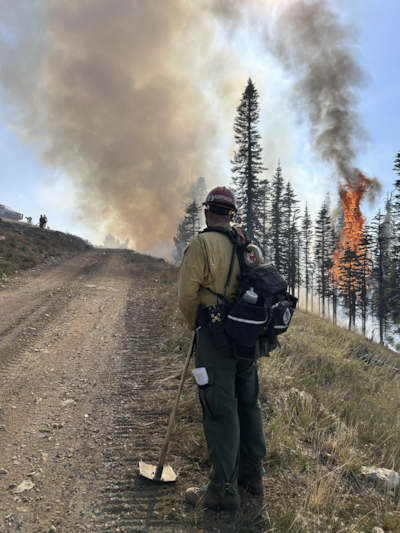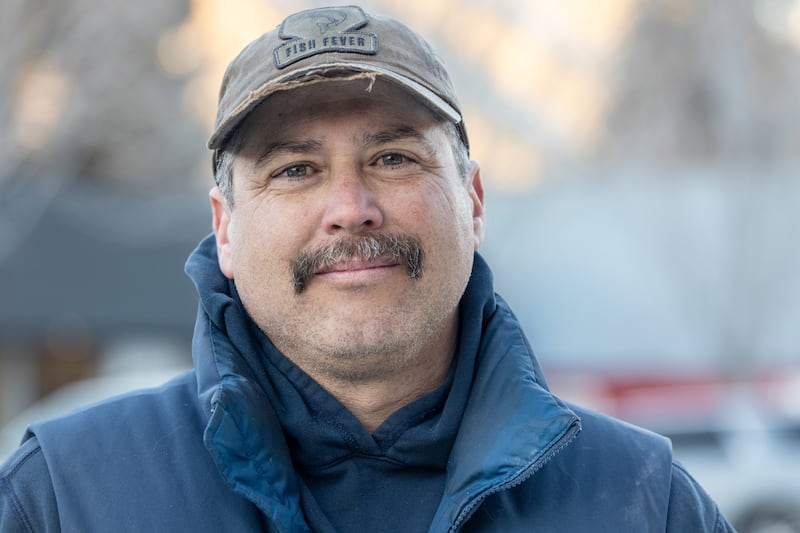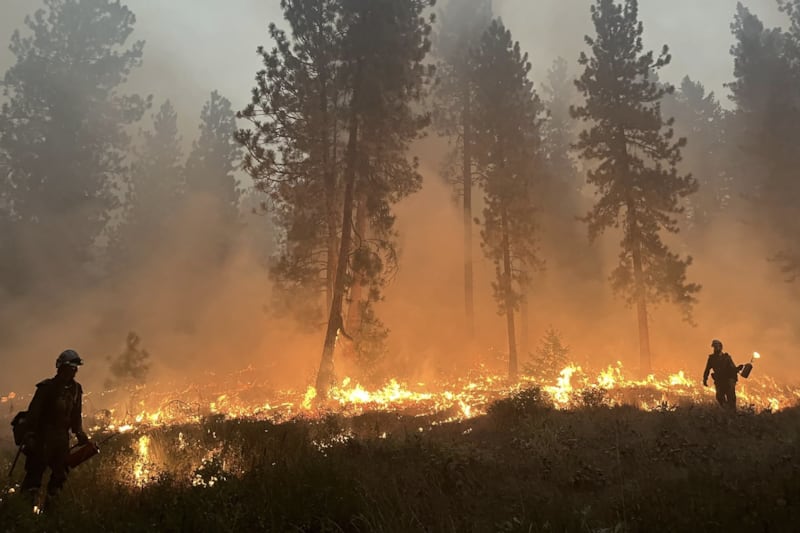It was a hazy day last August when Brianna Mitrione saw her first wildfire up close. It had broken out a week and a half earlier, when lightning struck near the Idaho-Oregon border, near a largely abandoned copper-mining town called Cuprum whose few remaining residents were, nonetheless, told to get ready to evacuate. Already big enough to be named, the Limepoint Fire engulfed tens of thousands of acres in just over a week, including the Hells Canyon National Recreation Area, and covered the Payette National Forest, all the way down to McCall, in an acrid fog. The front lines were staffed by “interagency hotshot crews” — highly trained professional firefighters, the elites who are dispatched to the most intense and threatening fires.
But those 100 or so hotshot crews were no match for the dozens of wildfires burning across the West last summer. They were spread thin across the biggest blazes, leaving other federal firefighters to fill the gaps. Yet sometimes — oftentimes — those gaps also got too big. When that happened, Forest Service employees like Mitrione were next in line to contain the flames.
Mitrione’s official job title was “forestry technician.” But like many Forest Service workers, she’d also notched some firefighting qualifications, and her boss put her on a “Type 2 handcrew” — a group that, while not considered “hotshot” status, works near the front lines of wildfire response, constructing fire lines and mopping up embers.
As she and the crew made their way toward the heart of the fire that August day, the air was so smoky you could feel it. Their job was to clear-cut a corridor through the forest so that, should the fire come that way, it wouldn’t have access to as much fuel. A line of people with chainsaws went in first. Mitrione and the rest of the crew followed, clearing the land. At that point, they still couldn’t see much of the fire. But as evening approached, conditions along the front lines were deteriorating.

“Hotshots were burning,” she remembers about the crews on the front lines. Leadership needed extra crews to staff the periphery, stomping wayward embers before they could light new patches of fire. Mitrione and her group carried their heavy packs, inhaling smoke and a fine, dusty powder kicked up by the flames as the winds picked up. Now they could not only see the fire; they could feel it. They could hear the tumbling trees, the popping sap. Members of crews like hers, sometimes called “militia” — or “collateral duty fire crews” — aren’t necessarily full-time firefighters; they contribute on an as-needed basis. The problem is, they’re needed more and more often these days as fires burn bigger and hotter. However, as of February, Mitrione was no longer employed by the Forest Service. Neither were thousands of other people who filled similar gaps.
With fewer employees to fight historically larger and hotter fires, fears are growing that this fire season could call for more hands on deck, not fewer.
Their firing came from Elon Musk’s Department of Government Efficiency and the Trump administration’s broader promise of a less wasteful federal government. While nearly everyone can agree that cutting irresponsible spending of taxpayer dollars is a noble goal, DOGE’s early strategies for budget cuts have largely consisted of terminating the jobs of probationary employees. Mitrione, for instance, was terminated for performance with about three months left of probationary employment, even though her performance reviews have never been problematic.
The Trump administration insists that it hasn’t cut any firefighters. Technically, that’s true. But about 75 percent of the folks who have been laid off from the Forest Service during budget cuts are qualified to combat wildfires in some capacity — whether serving on militias, working on trail crews or filling logistical gaps for firefighting crews. Speaking more broadly, the budget-motivated terminations have also targeted federal workers across agencies that manage public lands. Seven trail workers in the Yellowstone Ranger District, which manages and monitors 800 miles of trail, were fired. Yosemite National Park and Grand Teton National Park experienced a hiring freeze for all trail positions, leaving inadequate time to fill positions for the upcoming summer. These shifts follow a 2024 fire season during which the Fish and Wildlife Service, the National Park Service, the Bureau of Land Management, the Bureau of Indian Affairs and the Forest Service managed a cumulative 14,276 wildfires. These agencies face the annual pressure to combat fires on their own lands, while also cooperating when fires cross borders. And with fewer employees to fight historically larger and hotter fires, fears are growing that this fire season could call for more hands on deck, not fewer.
Wildfire season is coming regardless. And the West could be less prepared than ever before.
‘We are all fire’
Ryan Santo stood outside of Jane’s art store in Hailey, Idaho, on a Wednesday afternoon in February. Middle-aged with a dark mustache and a “Fish Fever” ballcap, he worked in Idaho fisheries for over 20 years before joining the Forest Service as a fisheries biologist in 2023. He loved it, aside from getting “bogged down” in red-tape policies that made it hard to get some things done. Folks in government positions are broadly open to “efficiency,” Santo says. “If you want to be more efficient, maybe there is some trimming of the fat. But the people who got fired last week, me included, are people on the ground. ... It doesn’t make any sense.”
What bothers him the most is how untargeted the firings have been. Because DOGE relied on a loophole allowing for recent hires on temporary probation to be more easily let go, the cuts felt like they came at random. “What they’re doing is just going in with a hammer — ‘You’re fired!’ Then, ‘Look, look, look, what we did! We cut the government by whatever percent, and now we’re more efficient!’” Santo says. “And it’s the opposite. They’re not going to be more efficient.”

Santo’s role in fire response was to serve as an adviser to the firefighters on the front lines, using his fisheries knowledge to preserve waterways. Last fall, when fires broke out during spawning season for chinook salmon, Santo worked with fire crews to mitigate damage to their spawning run. And when fire crews mistakenly dropped a batch of retardant into a stream, he wrote a report on how to clean up what basically amounted to a chemical spill. He wonders who will do that now.
Kelly Nichols worked as a support services specialist, which she explains as “office manager, plus.” The “plus” included serving as the hospital and family liaison for the Sawtooth National Forest — coordinating a response when forestry workers are injured or die and informing the public about wildfires. “The administration keeps saying that it was non-fire probationary positions that were terminated, and that’s just not true,” she says. “We are all fire.”
The administration insists no firefighters have been terminated. Technically, that’s true. But about 75 percent of those recently laid off are qualified to combat wildfires in some capacity.
Nichols was fired just one month short of her probation period ending. Santo’s notice came eight days prior. His wife had battled cancer for 18 months. His 8-year-old son, like Santo himself, has Type 1 diabetes. “These are real people that this is happening to,” he says. “And it’s not making anything more efficient.” It’s impossible to say exactly how much money the cuts in the Forest Service have saved taxpayers, because the individual salaries of the people involved have not been made public. But the average Forest Service salary, according to DOGE’s own numbers, is $74,414. Assuming the 3,400 fired folks made an average salary (which many did not, since they were newer, probationary employees) that amounts to $253,007,600 in savings — or $1.57 per American taxpayer. The true number is likely much lower, not only because of the probationary status of the fired workers, but because of cost considerations like unemployment benefits, termination paperwork and lawsuits. Not to mention the cost of not having the right people on the lines when fire season starts.

“We did lose a lot of folks that held fire (qualifications),” says Jake Renz, a mustached fire management officer who kept his job. “We’re going to have less folks to cover all the stuff we had to do last year.” As of April 1 — a long way from peak fire season — there were already 17 large fires burning across the U.S., with nearly 2,500 personnel assigned to combat them. And more serious fires are likely on the way at a time when summer temperatures, fueled in part by greenhouse gas emissions, have risen from an all-time low of 2.32 degrees below average in 1910 to an all-time high of 2.6 degrees above average in 2021; and when nine of the 10 costliest fires for insured loss in American history have occurred since 2017.
Firefighting on the scale of large wildfires requires cooperation across multiple local, state and federal organizations, most of which have signed agreements in advance and are part of established hierarchies. For example, if a fire is burning in a national forest, the Forest Service will respond first. But if the fire threatens private land, local fire departments can also get involved preemptively thanks to those written agreements. The same would be true of a fire that straddles the line between a national forest and a national park. And each organization has its own chain of command. So a given national forest will have its own fire crew, under the command of a fire staff officer and directed by a local fire dispatch center. When local fires get too big, the fire staff officer can turn to a regional dispatch center for help, followed by the National Interagency Fire Center in Boise, which coordinates and commands the hotshot crews. A given national forest might have its own dedicated hotshot crew, but that crew is a national resource that can be sent anywhere in the country if the National Interagency Fire Center deems it necessary. For that reason, local dispatch centers also maintain their own full-time non-hotshot crews.
“It’s a very specific process,” says Riva Duncan, a former wildland firefighter and fire staff officer who is now the vice president of Grassroots Wildland Firefighters. “You’re ordering additional resources, and it’s usually what’s closest, right? Because that’s more effective, more efficient. And it goes out from there to support whoever’s having large fires.”
This interagency cooperation came into play during the recent catastrophic wildfires in greater Los Angeles. The Eaton Fire, Duncan says, burned right on the border of the Angeles National Forest, which gave Forest Service firefighters the green light to fight the blaze alongside city and county resources. “It’s kind of all-hands-on-deck when it’s something that catastrophic,” she says. “That’s how it should be.”
The Forest Service claims about 35,000 employees on its website. It doesn’t publish numbers about how many are fire-qualified, but Duncan estimates that it’s somewhere in the 60 to 70 percent range. At least among the folks working in the field. And many of those field stations were understaffed to begin with. “Some of these agencies are already extremely skeletal, and now we’re going to see even less capacity, even more dysfunction,” says Amanda Monthei, a writer, podcaster and experienced wildland firefighter. “I worry about what that’s going to do in the peak of summer, when there’s 1,000 other fires burning all over the American West.”

Cutting costs without benefits
Inside a Seventh-day Adventist church in McCall, Idaho, Kelly Grenquist’s red hair bobs amid the crowd as she sorts through packets of string cheese and boxes of Rice-A-Roni that the local Albertsons market donated for recently fired federal workers like her. Before this community benefit potluck for those who found themselves suddenly jobless, she told another reporter that she planned to take her camper and “just start driving until you can be homeless and not freeze to death.”
Anywhere like that is probably the most at risk for wildfires in the coming years. FEMA maintains a National Wildfire Risk Index that’s dominated by states in the West, Southwest, and near the Atlantic and Gulf coasts. “The Southwest has always had fires,” says Duncan. “Then the monsoons come in, and they’re done, and (those fire crews) help everyone else.” But in the South, climate change is making wildfire more of a threat — especially when the region’s population density is much higher than in the arid West. “It may not happen every year like we see in the West,” Duncan says, “but it’s still happening.” And given the recent wave of federal layoffs, we may not only be less prepared to fight them; we may also know a lot less about them.
The National Interagency Fire Center maintains daily (during most of the year) and weekly (during winter) Fire Preparedness Level reports, which assign danger levels by region based on a scale of 1 (lowest risk) to 5 (highest risk). These reports help inform where fire resources are sent and where escalations might be expected. They rely in part on forecasts from organizations like the National Weather Service and the National Oceanic and Atmospheric Administration, which both lost thousands of employees to DOGE layoffs. “It’s just another thing that compounds and makes this job riskier than it already is,” says Duncan. Those reports help meteorologists issue “red flag warnings,” which tell firefighters, land management agencies and the public to expect ideal conditions — strong winds, low humidity and a chance for lightning — for wildfires to start. Over 17,000 fires are caused by lightning strikes alone every year, and even a slight shift in winds can spur a conflagration — the sort of devastating blazes that tore through Southern California in January. These forecasts help crews and officials plan firefighting procedures and evacuations accordingly.
Duncan adds that some federal meteorologists, known as “incident meteorologists,” are qualified to assist on wildfires specifically, offering practical advice to crews on how to avoid dangerous weather situations. “We rely on them for specific forecasts about fire danger,” Duncan says. It’s subtleties like that, buried within the inner workings and practicalities of wildfire management, that many federal employees — current and former — feel are getting lost in the chaos of politics. And come summertime, it won’t matter how much money was saved by layoffs if there aren’t enough folks to hold fire lines. At best estimates, DOGE could save an estimated $250 million with layoffs in the Forest Service — 10 percent of the agency’s total calculated salaries. The 2018 Camp Fire that tore through California caused $16.5 billion in losses, or over 50 times more than those savings are worth. Losses from January’s Palisades and Eaton fires, meanwhile, are estimated to cost $50-75 billion. Those nuances feel lost in the disconnect between the people fighting fires and the administration making cuts.
Considering the circumstances, the mood is upbeat in the church. There’s laughter and chatter and warmth. But nobody really knows what’ll happen once blazes start burning across the West. Or even before, with mitigation projects like prescribed burns and vegetation removal potentially stalled.
The average Forest Service salary is $74,414. Assuming the 3,400 fired folks made an average salary, the layoffs amount to $253,007,600 in savings — or $1.57 per American taxpayer.
Brad LaPlante, a forestry employee and union steward for the local chapter of the National Federation of Federal Employees, suspects the government will have to rely on more contractors to make up what’s been lost. They already fill in gaps when the Forest Service and local agencies are stretched too thin, but he predicts that relationship will accelerate. And when it does, he wonders if we’ll start to get some answers about real savings. “It is a lot cheaper to have an actual agency that’s able to handle its own mission than to force it to contract out,” he says.
Contractor firefighters are paid, at minimum, around $27 per hour — a standard set by the Department of Labor. However, many companies charge more, and the final cost varies substantially from one company to another (the official U.S. government spending database, USAspending.gov, reports contracts with well over 500 companies in fiscal year 2024). The average starting salary for an entry-level federal wildland firefighter, meanwhile, is between $15-17 per hour. Right away, there’s a compensation gap. But it can get much wider than $10 per hour. There’s a reason, Duncan says, that contractors have historically been the last line of defense after local, state and federal resources have been exhausted. “It’s because they cost more,” she says. “Contract firefighters are way more than federal firefighters. Everybody knows it.” Yet as far as she’s heard, contract firefighters have not been impacted by DOGE’s cuts. In fact, she’s heard the opposite. When we spoke in March, crews of them were battling fires in the Southeast. They seemingly hadn’t been affected at all. Like LaPlante, Duncan suspects that’s on purpose. “I think it’s totally part of the plan,” she said. “I think they will justify it by saying it provides jobs in the private sector” — even if those jobs end up costing taxpayers more than the ones they’re replacing.
That word, “if,” comes up a lot in these discussions, because everything is changing so fast. Mitrione, for example, filed an appeal to reverse her firing on the very same day that the USDA, which oversees the Forest Service, issued a “45-day stay on termination of probationary employees.” A few days later, she was told that she would be invited back, along with her fired timber crew colleagues. But she has no idea whether the reversal will last, or whether she’ll be fired later on regardless, or whether a new court ruling will eventually make yet another firing null and void. “I just don’t know how things are going to look,” she says. In some ways, the situation mirrors the chaos of an actual wildfire: When containment efforts fail and firefighters are overwhelmed, flames chew through trees and roads and homes at random. They push people out of their way, and they spread, and they consume whatever sits in their path.
If, that is, there’s anything left to burn down.
This story appears in the May 2025 issue of Deseret Magazine. Learn more about how to subscribe.


